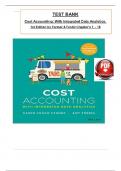,
,Test Bank for Cost Accounting: With Integrated
il il il il il il
DataAnalytics, 1st Edition by Karen Congo Farmer
il il il il il il il il
CHAPTER 1 il
COST ACCOUNTING HAS PURPOSE il il il
CHAPTER LEARNING OBJECTIVES il il
1. Explore the elements that support a company’s purpose, as well as your own.
il il il il il il il il il il il il
2. Connect the purpose of cost accounting with the role of accountants in organizations.
il il il il il il il il il il il il
3. Outline the frameworks, including ethics, that guide the profession.
il il il il il il il il
*4. Increase your chances of success by becoming a lifelong learner.
il il il il il il il il il
Current count is: il il
Knowledge: 106 il
Comprehension: 5 i l
Application: 0 i l
Analysis: 0 il
Evaluation: 0 il
Synthesis: 0 il
Total: 111 il
Number and percentage of questions:
il il il il
Easy: 27 questions, 24 percent (target of 25%)
i l il il il il il il
Medium: 74 questions, 66 percent (target of 65%)
i l il il il il il il
Hard: 10 questions, 9 percent (target of 10%)
i l il il il il il il
Question types: il
Multiple Choice: 93 il il
Exercises: 18 il
, 1-2 Test Bank for Cost Accounting, First Edition
MULTIPLE CHOICE QUESTIONS il il
1. A helps an organization, whether for profit or nonprofit, turn its purpose il il il il il il il il il il
intoaction by establishing the direction of the entity.
il il il il il il il il il
a. mission statement il
b. strategic plan il
c. SWOT analysis il
d. vision
Ans: ilB, ilLO il1, ilBloom: ilK, ilDifficulty: ilMedium, ilAACSB: ilAnalytic, ilAICPA: ilFC: ilMeasurement, ilAnalysis, iland ilInterpretation, ilIMA: ilBusiness ilAcumen il&
ilOperations: ilOperational ilKnowledge.
Solution: ilA ilstrategic ilplan ilhelps ilan ilorganization, ilwhether ilfor ilprofit ilor ilnonprofit, ilturn ilits ilpurpose ilinto ilaction ilby ilestablishing ilthe ildirection ilof ilthe ilentity.
2. An organization’s strategic plan includes its why, where and how for its purpose representedby
il il il il il il il il il il il il il il
a. opportunities, strengths and weaknesses. il il il
b. opportunities, strengths, and mission. il il il
c. mission, vision, and strategy. il il il
d. mission, strengths, and strategy. il il il
Ans: ilC, ilLO il1, ilBloom: ilK, ilDifficulty: ilMedium, ilAACSB: ilAnalytic, ilAICPA: ilFC: ilMeasurement, ilAnalysis, iland ilInterpretation, ilIMA: ilBusiness ilAcumen
il&ilOperations: ilOperational ilKnowledge.
Solution: ilAn ilorganization’s ilstrategic ilplan ilincludes ilits ilwhy, ilwhere, iland ilhow ilfor ilits ilpurpose ilrepresented ilby ilmission, ilvision, iland ilstrategy.
3. In choosing a strategy, a business begins by undertaking a thorough examination of itself andthe
il il il il il il il il il il il il il il il
industry within which it operates by performing a
il il analysis. il il il il il il
a. mission and vision statement il il il
b. strategic initiative il
c. target objective il
d. SWOT
Ans: ilD, ilLO il1, ilBloom: ilK, ilDifficulty: ilMedium, ilAACSB: ilAnalytic, ilAICPA: ilFC: ilMeasurement ilAnalysis iland ilInterpretation, ilIMA: ilBusiness ilAcumen il&
ilOperations:ilO perational ilKnowledge.
Solution: ilIn ilchoosing ila ilstrategy, ila ilbusiness ilbegins ilby ilundertaking ila ilthorough ilexamination ilof ilitself iland ilthe ilindustry ilwithin ilwhich ilit iloperates ilby ilperforming ila
ilSWOT ilanalysis.
4. An organization’s il is its purpose; its reason for existing.
il il il il il il
a. mission
b. strategy
c. initiative
d. strategic plan il
Ans: ilA, ilLO il1, ilBloom: ilK, ilDifficulty: ilMedium, ilAACSB: ilAnalytic, ilAICPA: ilFC: ilMeasurement, ilAnalysis, iland ilInterpretation, ilIMA: ilIMA: ilBusiness ilAcumen
il&ilOperations: ilOperational ilKnowledge.
Solution: ilAn ilorganization’s ilmission ilis ilits ilpurpose, ilits ilreason ilfor ilexisting.
5. A SWOT analysis allows an organization to assess its
il il il il il il il il
a. strategies, wealth, outlets, and targets. il il il il
b. strengths, warnings, outlets, and threats. il il il il
c. strengths, weaknesses, opportunities, and threats. il il il il
d. strategies, wealth, opportunities, and threats. il il il il
Ans: ilC, ilLO il1, ilBloom: ilC, ilDifficulty: ilEasy, ilAACSB: ilAnalytic, ilAICPA: ilFC: ilMeasurement, ilAnalysis, iland ilInterpretation, ilIMA: ilBusiness ilAcumen il&
ilOperations:ilO perational ilKnowledge.
Solution: ilA ilSWOT ilanalysis ilallows ilan ilorganization ilto ilassess ilits ilstrengths, ilweaknesses, ilopportunities, iland ilthreats.




